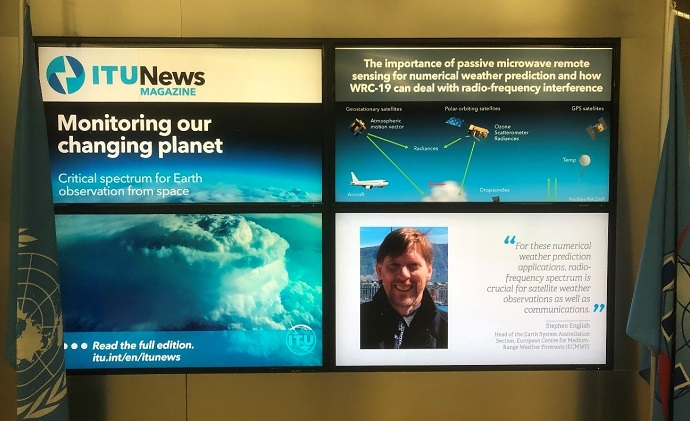
Stephen English, Head of Earth System Assimilation Section at ECMWF
Numerical weather prediction (NWP) relies on observations from Earth observation satellites, radiosondes, aircraft, radar and other observing systems as inputs. In turn, these observing systems rely on the allocation of radio frequency bands both for directly observing the atmosphere and the planet and for exchanging observations through telecommunication networks. These allocations are defined in international agreements and regularly updated at an event called the World Radiocommunication Conference (WRC) in the light of new requirements. The next WRC, WRC‑19, takes place this coming November. The World Meteorological Organization (WMO), with strong support from space agencies such as EUMETSAT and ESA, as well as EUMETFREQ (a EUMETNET programme), coordinates the response of the international meteorological community and represents the community at WRC‑19. Their goal is to ensure that frequencies used operationally at centres like ECMWF continue to be allocated to this application area, without interference from new users. This process is increasingly challenging as many new application areas are emerging that require frequency bands, for example the next-generation mobile phone data service, 5G. In the WRC, the demands of different application areas need to be weighed up, taking into account economic and societal benefits. The idea is not to hamper new technologies, such as 5G, but to make sure that their implementation does not interfere with life-saving applications, such as weather prediction.
A proactive approach
For the meteorological case to be fairly heard, the spectrum managers who make decisions on radio-frequency allocations need the best and most up-to-date information on the value of the bands to meteorology, in terms that can be compared to other application areas. This enables them to try to ensure continued allocation of the required frequencies to the Earth Exploration-Satellite Service (EESS), as well as protecting these frequencies from out-of-band emissions from neighbouring frequency bands.
ECMWF has been proactive in providing information and coordinating inputs from the wider meteorological community to support the WMO and the space agencies. In particular, we organised a workshop on radio frequency interference in September 2018, which was attended by representatives of many major NWP centres. Following this, we made our case through an article for the International Telecommunication Union (ITU) News Magazine, which gained prominence at the ITU headquarters. Media interest in this topic has helped to develop a broader understanding of the meteorological use of radio frequencies, for example through an article published by Nature News entitled ‘Global 5G wireless networks threaten weather forecasts’.

ITU News Magazine article. An article by Stephen English on the issue of radio frequency interference was published in the ITU News Magazine 01/2019 and advertised at the ITU headquarters.
The value of passive microwave sensing
Many satellite observations for NWP use passive sensing techniques in radio frequency bands. Such passive measurements are made by very sensitive instruments that measure the very low-power microwave radiances naturally emitted from the atmosphere and the Earth’s surface. These passive techniques are the most vulnerable to interference from new users of radio frequencies generating electromagnetic emissions for their own purposes. Passive sensing makes it possible to gain information on the current state of the Earth system by exploiting the absorption characteristics of the atmosphere. There are absorption peaks due to the molecular resonance of atmospheric gases, including water vapour. There is also absorption and scattering by clouds and precipitation, which increase with frequency, and a slow increase in absorption by water vapour with increasing frequency. How efficiently the Earth’s surface emits and reflects microwave radiation also changes slowly with increasing frequency.

The WMO Integrated Global Observing System (WIGOS). Satellite observations, including those that use passive sensing techniques in radio frequency bands, are a crucial part of the WMO Integrated Global Observing System (WIGOS) used to support numerical weather prediction. (Source: WMO)
The use of radio frequencies in meteorology is not limited to these passive microwave observations. Systems such as weather radar also suffer from radio frequency interference. Radiosondes rely on a specific allocation for tracking and telecommunication. Command and download of data from all satellites needs specific frequency allocations. All these allocations are every bit as important as the passive allocations.
Why we need to act
NWP users are already seeing evidence of radio frequency interference in the L (~1.4 GHz), C (~6.9 GHz), X (~10.7 GHz) and K (~18.7 GHz) frequency bands, notably on the European SMOS instrument and the Japanese AMSR2 instrument. Loss of these and other bands would have a detrimental impact on national weather warning systems as well as our ability to monitor climate change through the Copernicus Climate Change Service (C3S), implemented by ECMWF on behalf of the EU. New applications (e.g. 5G) outside the field of meteorology are interested in higher frequencies, e.g. in bands adjacent to 24 GHz and 50 GHz, which are crucial for obtaining accurate estimates of water vapour and temperature in the analysis, from which the forecast is then run. Although the radio regulations prohibit all emissions in the passive allocations at 24 and 50 GHz, we also have to ensure protection is in place to limit the level of out-of-band emissions from active systems operating in neighbouring bands (e.g. emissions from the 5G band between 24.25 GHz and 27.5 GHz affecting the passive band 23.6–24.0 GHz).
In a world hungry for the use of radio frequencies in new applications, meteorological centres such as ECMWF need to be clear about their critical value for weather prediction. The next key event is the World Radiocommunication Conference in November 2019. ECMWF’s high level of activity this year reflects the fact that there are many questions for that meeting that will decide the future viability of many bands used for operational weather forecasting. ECMWF will continue to support the WMO and space agencies in this important activity.
This blog post is an edited version of an article published in the summer 2019 issue of the ECMWF Newsletter.
